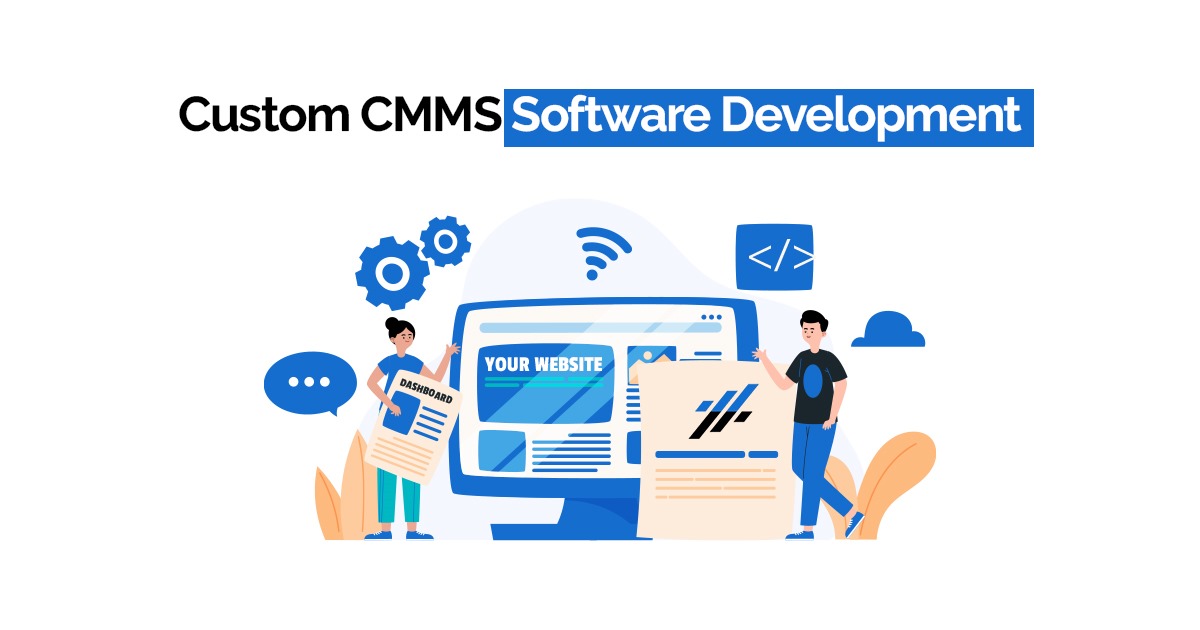Custom CMMS software development is all about creating a maintenance system that fits your business like a glove. Whether you’re managing machinery, equipment, or entire facilities, a well-built CMMS helps you keep things running smoothly. If you’ve been asking, “What is CMMS software?” it’s essentially a tool that helps businesses plan, track, and manage maintenance tasks. There’s a lot of buzz around finding what is the best CMMS software, but the real solution lies in building something that meets your specific needs.
For industries like manufacturing, where downtime can cost a fortune, CMMS software for manufacturing becomes a game-changer. There are plenty of CMMS software examples out there, but none can compare to the customization and flexibility of your own system. Resources like custom CMMS software development GitHub and guides in PDF format make it easier to start building a system that delivers real results.
What is CMMS Software?
CMMS software stands for Computerized Maintenance Management System, and it’s designed to make life easier for businesses managing maintenance tasks. Think of it as a digital tool that helps you plan, organize, and monitor everything related to keeping your equipment, facilities, or assets in top shape. From scheduling regular inspections to tracking repairs and inventory, a CMMS handles it all.
People often search for what is CMMS maintenance software or wonder what is the best CMMS software. The answer depends on your business needs. Many industries, especially manufacturing, rely on CMMS software for manufacturing to avoid costly downtime and manage complex systems. While there are plenty of CMMS software examples, custom solutions often win because they address specific challenges. Tools like custom CMMS software development GitHub repositories and detailed PDF guides are helping businesses create their own systems.
Benefits of CMMS Software: 10 Key Advantages
- Improved Maintenance Scheduling: Plan and track maintenance tasks to reduce delays and unexpected breakdowns.
- Centralized Asset Management: Manage all equipment, tools, and facilities in one system for better organization.
- Reduced Downtime: Use predictive maintenance features to minimize equipment downtime.
- Cost Tracking: Monitor maintenance costs and make informed budgeting decisions.
- Inventory Control: Keep an eye on spare parts and supplies to avoid stockouts.
- Enhanced Reporting and Analytics: Generate detailed reports to analyze performance and make data-driven improvements.
- Regulatory Compliance: Maintain accurate records for inspections and audits with ease.
- User-Friendly Interface: Simplifies the management of maintenance tasks, even for non-technical staff.
- Scalability for Manufacturing: Adapt CMMS software for manufacturing to handle complex production lines.
- Integration with Existing Systems: Combine CMMS with other software, like ERP or IoT systems, for smooth workflows.
Custom CMMS Software Development: Why It Matters
Custom CMMS software development is the process of creating a system that fits the unique needs of your business. Unlike generic solutions, custom CMMS software lets you focus on what matters most—whether it’s asset management, maintenance tracking, or optimizing workflows. While many businesses wonder what is the best CMMS software, the truth is, the “best” system is one that meets your specific requirements.
Industries like manufacturing rely heavily on CMMS software for manufacturing, where downtime can lead to massive losses. Instead of adjusting your operations to fit off-the-shelf CMMS software examples, custom solutions let you build a system that aligns with your processes. With tools like custom CMMS software development GitHub repositories and helpful PDF guides, creating your own system is more accessible than ever. It’s about solving real problems, not compromising with one-size-fits-all options.
Why Custom CMMS Software is a Game-Changer
- Built Around Your Needs: Focus on the exact features your business requires, avoiding unnecessary extras.
- Better Control Over Maintenance: Design workflows that prioritize maintenance tasks important to your operations.
- Scalable for Growth: Adjust the system as your business expands, whether in size or complexity.
- Integration with Existing Tools: Combine with current systems like ERP or IoT platforms for smoother operations.
- Enhanced Productivity: Simplify task assignments and tracking to reduce wasted time.
- Improved Data Security: Develop a system with custom security measures to protect sensitive data.
- Cost-Effective in the Long Run: Eliminate subscription fees and only pay for what you use.
- Better Asset Tracking: Keep a close eye on asset performance and lifecycle for better planning.
- Tailored for Manufacturing: Handle unique challenges of production lines with CMMS software for manufacturing.
- Easier Customization and Updates: Modify and upgrade the system as technology evolves without restrictions.
Steps in Custom CMMS Software Development
· Define Business Needs: Understand the specific maintenance requirements of your business and outline the key features needed in the system.
· Design the System: Create a system blueprint, focusing on user experience, data flow, and integration with existing tools.
· Develop the Solution: Begin coding the CMMS system, making sure it meets the defined requirements and works with other tools like ERP systems.
· Testing and Debugging: Conduct thorough testing to identify and fix any issues before the system goes live.
· Deployment and Ongoing Support: Deploy the system and provide regular updates and support to ensure it stays functional and relevant.
Comparison of Popular CMMS Software
When considering what is the best CMMS software, businesses often compare solutions based on features, usability, and cost. Here’s a quick overview:
| CMMS Software | Key Features | Ideal For |
| IBM Maximo | Asset management, predictive maintenance | Large enterprises |
| Fiix | Cloud-based, mobile app support | Small to mid-sized businesses |
| Maintenance Connection | Work order management, reporting | Manufacturing sectors |
While CMMS software examples like these are widely used, a custom CMMS software development approach might offer more flexibility for specific industry needs.
Custom CMMS Software Development Resources
When embarking on custom CMMS software development, having the right resources is essential. Platforms like GitHub allow developers to collaborate, share code, and troubleshoot problems as they build the system. There are also numerous custom CMMS software development PDF guides that provide detailed instructions for setting up a successful system. These resources help ensure that your custom solution is not only effective but also easy to maintain and update. With these tools, developers can access everything they need to create a powerful CMMS solution tailored to your business needs.
Conclusion: Choosing the Right CMMS Solution
Choosing the right CMMS solution is crucial for ensuring effective maintenance management. Whether opting for custom CMMS software development or a ready-made system, it’s essential to consider your business’s specific needs. A well-chosen CMMS solution can reduce downtime, extend asset life, and optimize your overall operations.
- Assess your business needs before making a choice.
- Look for scalability to adapt as your business grows.
- Consider integration capabilities with existing software.
- Evaluate user-friendly interfaces for easy adoption.
- Choose a solution that offers reliable support and updates.
Frequently Asked Questions (FAQs)
How to Create a CMMS Program?
To create a CMMS program, start by defining your business’s maintenance needs and objectives. Then, design the system architecture, focusing on asset management, scheduling, and reporting. After coding the software, conduct thorough testing to ensure it functions well with existing tools. Finally, deploy the solution and offer ongoing support.
Is SAP a CMMS or an ERP?
SAP is an ERP (Enterprise Resource Planning) system, not a dedicated CMMS. While SAP has some features related to asset management and maintenance, it is broader in scope, managing various business functions such as finance, procurement, and HR. CMMS, on the other hand, is focused on maintenance management.
What are the Two Types of CMMS Used in the Industry?
The two main types of CMMS used in the industry are cloud-based CMMS and on-premise CMMS. Cloud-based CMMS is hosted online and accessible from any device, while on-premise CMMS is installed and maintained on local servers. Both types offer benefits depending on the organization’s infrastructure and needs.
What Are the Drawbacks of CMMS?
Despite its benefits, CMMS can have drawbacks. These include the high initial cost of custom development, the need for training employees to use the system effectively, and potential resistance to adoption. Additionally, complex systems may require ongoing maintenance and updates, leading to higher long-term operational costs.


